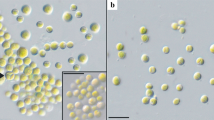Abstract
A fossil vegetative cell of desmidian algae is described as a new species—Closterium mosbruggeri sp. nov. It occurs in middle Miocene (late Serravallian) sediments from Northwest Bulgaria. The present record of Closterium is the first fossil record of this genus in vegetative stage in Europe and the third in the world. The fossil species is characterised by a single, long, straight cell. The cell wall is thin with a smooth surface. The cell is flattened forming a long, frond-like shape tapering at both ends. Closterium is a green alga belonging to the Closteriaceae family, occurring exclusively in freshwater environments.




Similar content being viewed by others
References
Baschnagel, R. A. (1966). New fossil algae from the Middle Devonian of New York. Transactions of the American Microscopical Society, 85(2), 297–302.
Coesel, P. F. M. (1996). Biogeography of desmids. Hydrobiologia, 336, 41–53.
Coesel, P. F. M., & Krienitz, L. (2008). Diversity and geographic distribution of desmids and other coccoid green algae. Biodiversity and Conservation, 17, 381–392.
Ettl, H., & Gärtner, G. (1995). Syllabus der Boden-, Luft- und Flechtenalgen. Stuttgart: Gustav Fischer.
Geel, B. van, Bohncke, S. J. P., & Dee, H. (1981). A palaeoecological study of an upper late glacial and Holocene sequence from “De Borchert”, the Netherlands. Review of Palaeobotany Palynology, 31, 367–448.
Graham, L. E., Kodner, R. B., Fisher, M. M., Graham, J. M., Wilcox, L. W., Hackney, J. M., Obst, J., Bilkey, P. C., Hanson, D. T., & Cook, M. E. (2004). Early land plant adaptations to terrestrial stress: A focus on phenolics. In A. R. Hensley & I. Poole (Eds.) The evolution of plant physiology: From whole plants to ecosystems (pp. 155–170). Linnean Society of London: Elsevier Academic Press.
Graham, L. Е., Lewis, L. A., Taylor, W., Wellmann, C., & Cook, M. Е. (2014). Early terrestrialisation: Transition from algae to bryophyte grade. In D. T. Hanson & S. K. Rice (Eds.) Photosynthesis in Bryophytes and Early Land Plants, Advances in Photosyntnesis and Respiration, 37 (pp. 9–28). Dordrecht, Heidelberg, New York, London: Springer.
Guiry, M. D. (2013). Taxonomy and nomenclature of the Conjugatophyceae (=Zygnematophyceae). Algae, 28(1), 1–29.
Guiry, M. D., & Guiry, G. M. (2020). AlgaeBase. World-wide electronic publication. Galway: National University of Ireland http://www.algaebase.org. Accessed on 30 Jun 2020.
Ivanov, D., Ashraf, A. R., Mosbrugger, V., & Palamarev, E. (2002). Palynological evidence for Miocene climate change in the Forecarpathian Basin (central Paratethys, NW Bulgaria). Palaeogeography, Palaeoclimatology, Palaeoecology, 178(1–2), 19–37.
Ivanov, D., Tsenov, B., Utescher, T., Kováčová, M., Mosbrugger, V., & Ashraf, A. R. (2019). Climate reconstructions based on Miocene leaf flora from NW Bulgaria: Comparing leaf physiognomy and nearest living relative approach. Phytologia Balcanica, 25(2), 137–146.
John, D. M., Whitton, B. A., & Brook, A. J. (2002). The freshwater algal flora of the British Isles. An identification guide to freshwater and terrestrial algae. Cambridge: Cambridge Univ. Press.
John, D. M., Whitton, B. A., & Brook, A. J. (2011). The freshwater algal flora of the British Isles: An identification guide to freshwater and terrestrial algae (2nd ed.). United States of America: Cambridge University Press.
Kojumdgieva, E., Popov, N., Stancheva, M., & Darakchieva, S. (1989). Correlation of the biostratigraphic subdivision of the Neogene in Bulgaria after molluscs, foraminifers and ostracods. Geologica Balcanica, 19(3), 9–22. [in Russian with English abstract]
Krutzsch, W., & Pacltová, B. (1990). The phytoplankton-microflora from freshwater deposits in the Cheb Basin (Western Bohemia, CSFR). Acta Universitatis Carolinae-Geologica, 4, 420–435.
Palamarev, E., & Petkova, A. (1987). Sarmatian macroflora. – In V. Tzankov (Ed.) Fossils of Bulgaria, 8(1): 3–275. Bulgarian Academy of Sciences Publishing House, Sofia. [In Bulgarian with French summary]
Songtham, W., Ratanasthien, B., & Mildenhall, D. (2004). New species of algae Actinastrum Lagerheim and Closterium Nitzsch ex Ralfs from Middle Miocene sediments of Chiang Muan basin, Phayao, Thailand, with tropical pollen composition. Science Asia, 30, 171–181.
Worobiec, E. (2014). Fossil zygospores of Zygnemataceae and other microremains of freshwater algae from two Miocene palaeosinkholes in the Opole region, SW Poland. Acta Palaeobotanica, 54(1), 113–157.
Acknowledgements
We acknowledge critical remarks and valuable suggestions of the reviewers (Prof. Maya Stoyneva-Gärtner, and two anonymous reviewers). Our sincere gratitude goes to Dr. Torsten Utescher, who as a guest editor helped us improve the manuscript and to all guest editors, Angela Bruch, Dieter Uhl, and Torsten Utescher for inviting us to contribute to this special issue.
Funding
This work was supported by the National Science Program “Environmental Protection and Reduction of Risks of Adverse Events and Natural Disasters”, approved by the Resolution of the Council of Ministers № 577/17.08.2018 and supported by the Ministry of Education and Science (MES) of Bulgaria (Agreement № D01- 230/06.12.2018 and № DO1-322/18.12.2019). It is a contribution to the International Network Programe NECLIME (www.neclime.de).
Author information
Authors and Affiliations
Contributions
All authors read and approved final manuscript.
Corresponding author
Ethics declarations
Conflict of interest
The authors declare that they have no conflict of interest.
Additional information
Publisher’s note
Springer Nature remains neutral with regard to jurisdictional claims in published maps and institutional affiliations.
This article is a contribution to the special issue “Palaeobotanical contributions in honour of Volker Mosbrugger”
Rights and permissions
About this article
Cite this article
Ivanov, D., Belkinova, D. Closterium mosbruggeri sp. nov.: a new fossil species from the middle Miocene of Northwest Bulgaria. Palaeobio Palaeoenv 101, 69–74 (2021). https://doi.org/10.1007/s12549-020-00476-7
Received:
Revised:
Accepted:
Published:
Issue Date:
DOI: https://doi.org/10.1007/s12549-020-00476-7




